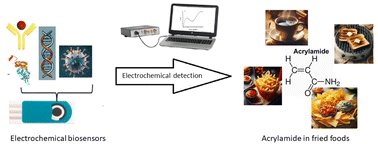Acrylamide in food products and the role of electrochemical biosensors in its detection: a comprehensive review
Abstract
In this review, the mechanisms of acrylamide formation in food, along with aspects related to its toxicity and associated consumption risks, are investigated, highlighting the potential impact on human health. European regulations regarding acrylamide content in food products are also addressed, emphasizing the importance of monitoring and detecting this substance in nutrition, by public health protection measures. The primary objective of the research is to explore and analyze innovative methods for detecting acrylamide in food, with a particular focus on electrochemical biosensors. This research direction is motivated by the need to develop rapid, sensitive, and efficient monitoring techniques for this toxic compound in food products, considering the associated consumption risks. The research has revealed several significant results. Studies have shown that electrochemical biosensors based on hemoglobin exhibited increased sensitivity and low detection limits, capable of detecting very low concentrations of acrylamide in processed foods. Additionally, it has been found that the use of functionalized nanomaterials, such as carbon nanotubes and gold nanoparticles, has led to the improvement of electrochemical biosensor performance in acrylamide detection. The integration of these technological innovations and functionalization strategies has enhanced the sensitivity, specificity, and stability of biosensors in measuring acrylamides. Thus, the results of this research offer promising perspectives for the development of precise and efficient methods for monitoring acrylamides in food, contributing to the improvement of food quality control and the protection of consumer health.

- This article is part of the themed collection: Analytical Methods Review Articles 2024


 Please wait while we load your content...
Please wait while we load your content...